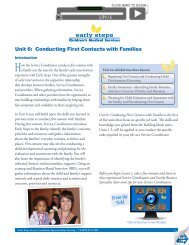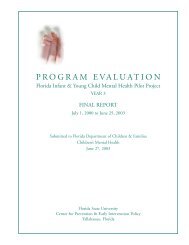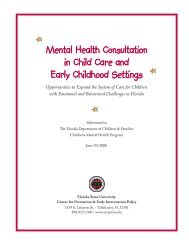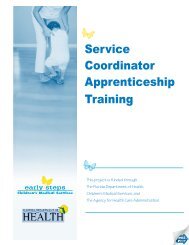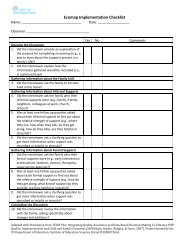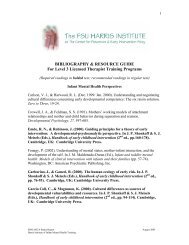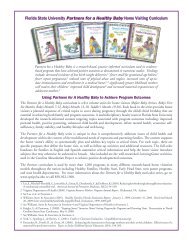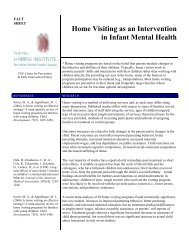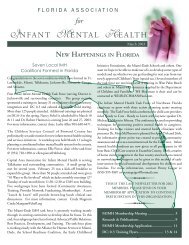Using Partners for A Healthy Baby to Achieve Program Outcomes
Using Partners for A Healthy Baby to Achieve Program Outcomes
Using Partners for A Healthy Baby to Achieve Program Outcomes
Create successful ePaper yourself
Turn your PDF publications into a flip-book with our unique Google optimized e-Paper software.
How the <strong>Partners</strong> <strong>for</strong> a <strong>Healthy</strong> <strong>Baby</strong> Curriculum Aligns with Core Elementsof Evidence-Based Home Visitation ServicesRecently, the National Home Visitation Steering Committee* (March 2009) proposed four Core Elements of EvidencebasedHome Visitation Services. The elements address program outcomes, program models and standards, programrecipients, and program providers. The <strong>Partners</strong> <strong>for</strong> a <strong>Healthy</strong> <strong>Baby</strong> curriculum is used in numerous programs that meetthe Core Elements. Positive outcomes achieved by evidence-based programs using the <strong>Partners</strong> curriculum are cited below.Core Element 1: Demonstrate ongoing positive outcomes that enhance child health and development by improvingprenatal health; pregnancy outcomes; child health; physical, cognitive, language and social emotional development;school readiness; academic success; positive parenting practices; parent involvement; reductions in child abuse, neglectand injury; birth intervals between pregnancies; family stability; economic self sufficiency; and maternal employment.Positive Birth <strong>Outcomes</strong>• The risk of delivering a low birth weight (LBW) baby was significantly lower <strong>for</strong> the <strong>Healthy</strong> Families New York(HFNY) mothers (5.1%) than <strong>for</strong> the control group mothers (9.8%).• HFNY mothers delivered fewer small <strong>for</strong> gestational age (SGA) babies (8.8%) than control group mothers (11.6%).—Lee, E., Mitchell-Herzfeld, S., Lowenfels, A., Green, R., Dorabawila, V., & DuMont, K. (2009). Reducing low birth weight through homevisitation: A randomized controlled trial. American Journal of Preventive Medicine, 36(2), 154-160.• Teens in the Virginia Resource Mothers (VRM) program had fewer low birth weight deliveries compared <strong>to</strong> overallteen state rates (7.7% vs. 10.3% in 2006) and (8.9% vs. 10.6% in 2007).—Virginia Department of Health. (2008). Virginia Resource Mothers <strong>Program</strong> Annual Report. Richmond, VA: Author.• Mothers who participated in the Tennessee HUGS program had an average gestational age of 37.5 weeks and anaverage number of prenatal visits of 10.0 per mother.—Tennessee Department of Health, Maternal and Child Health. (2011). Tennessee Home Visiting <strong>Program</strong>s Annual Report: July 1, 2009–June 30,2010. Nashville, TN: Author. Retrieved from http://health.state.tn.us/statistics/PdfFiles/Home_Visiting_<strong>Program</strong>s_Annual_Report_2010.pdfReduction in Child Abuse• A five-year evaluation, which used a quasi experimental design, found that children in <strong>Healthy</strong> Families Florida were3.7 times less likely than the comparison group <strong>to</strong> experience child maltreatment.• There was 58% less child abuse in families who received three or more years of service or completed the programcompared <strong>to</strong> families who received less than 3 months of services or no services.• The rate of child maltreatment <strong>for</strong> HFF participants was 20% less than <strong>for</strong> families in the target service areas.—Williams, Stern & Associates (2005). <strong>Healthy</strong> Families Florida Evaluation Report: January 1, 1999–December 31, 2003. Retrieved March 26,2009 from www.healthyfamiliesfla.org/pdfs/Final_Evaluation_1999-2003.pdf• Only one substantiated incidence of child maltreatment was reported <strong>for</strong> participants in the Cabarrus Health Alliance’sIntensive Home Visiting <strong>Program</strong> <strong>for</strong> Pregnant and Parenting Teens from 2004-2009.—Stepping S<strong>to</strong>nes Intensive Home Visiting <strong>Program</strong>. Quarterly Reports 2004–2009. Cabarrus Health Alliance, North Carolina.—Knight, S., & Patterson, J. (2008). “Stepping S<strong>to</strong>nes” Intensive Home Visiting <strong>Program</strong> <strong>for</strong> Pregnant and Parenting Teens. Presentation <strong>to</strong> NorthCarolina Smart Start Conference, May 6, 2008.• A <strong>to</strong>tal of 98% (1,100 of 1,133) of the children enrolled in the Tennessee CHAD program were free of child abuseand neglect as measured by DCS reported involvement in prior 12 months.• A <strong>to</strong>tal of 98.8% (1,387/1404) of the children served by Tennessee <strong>Healthy</strong> Start program did not exhibit signs ofabuse or neglect.—Tennessee Department of Health, Maternal and Child Health. (2011). Tennessee Home Visiting <strong>Program</strong>s Annual Report: July 1, 2009–June 30,2010. Nashville, TN: Author. Retrieved from http://health.state.tn.us/statistics/PdfFiles/Home_Visiting_<strong>Program</strong>s_Annual_Report_2010.pdf*Children’s Defense Fund, CLASP, CWLA, Fight Crime: Invest in Kids, Home Instruction <strong>for</strong> Parents of Preschool Youngsters, National ChildAbuse Coalition, Parents as Teachers National Center, Parent-Child Home <strong>Program</strong>, Prevent Child Abuse America/<strong>Healthy</strong> Families America,and Voices <strong>for</strong> America’s Children.2 Florida State University <strong>Partners</strong> <strong>for</strong> a <strong>Healthy</strong> <strong>Baby</strong> • www.cpeip.fsu.edu • September 2011
Birth Intervals Between Pregnancies• Of mothers enrolled in <strong>Healthy</strong> Families Florida, 92% did not have a subsequent pregnancy within 2 years of thetarget child’s birth.—Williams, Stern & Associates. (2005). <strong>Healthy</strong> Families Florida Evaluation Report: January 1, 1999–December 31, 2003. Retrieved March 26,2009 from www.healthyfamiliesfla.org/pdfs/Final_Evaluation_1999-2003.pdf• The rate of repeat pregnancy <strong>for</strong> VRM teen mothers was 5.1% compared <strong>to</strong> 20% <strong>for</strong> teens statewide.—Virginia Department of Health. (2008). Virginia Resource Mothers <strong>Program</strong> Annual Report. Richmond, VA: Author.• Of the women being served by the Tennessee <strong>Healthy</strong> Start program, 93% (1,028/1,106) were not pregnant one yearafter the birth of the previous child.• Of the 1,010 mothers with at least one previous birth being served by the Tennessee HUGS program, 924 (91.5%)had a birth interval greater than 12 months.—Tennessee Department of Health, Maternal and Child Health. (2011). Tennessee Home Visiting <strong>Program</strong>s Annual Report: July 1, 2009–June 30,2010. Nashville, TN: Author. Retrieved from http://health.state.tn.us/statistics/PdfFiles/Home_Visiting_<strong>Program</strong>s_Annual_Report_2010.pdfImproved Child Health• Of the <strong>Healthy</strong> Families Florida (HFF) target children, 92% had up-<strong>to</strong>-date immunizations compared with thestatewide rate of 77%.• Of the HFF participants, 97% were linked <strong>to</strong> a medical provider.• Over 90% of HFF children were up-<strong>to</strong>-date with well-baby checks at 3 and 4 years of age.—Williams, Stern & Associates. (2005). <strong>Healthy</strong> Families Florida Evaluation Report: January 1, 1999–December 31, 2003. Retrieved March 26,2009 from www.healthyfamiliesfla.org/pdfs/Final_Evaluation_1999-2003.pdfOf the participants in the Cabarrus Health Alliance’s Intensive Home Visiting <strong>Program</strong> <strong>for</strong> Pregnant and Parenting Teens:• 100% were enrolled in a medical home within 6 weeks of entry in<strong>to</strong> the program.• 100% of the children were up-<strong>to</strong>-date with their immunizations.—Knight, S., & Patterson, J. (2008). “Stepping S<strong>to</strong>nes” Intensive Home Visiting <strong>Program</strong> <strong>for</strong> Pregnant and Parenting Teens. Presentation <strong>to</strong> NorthCarolina Smart Start Conference, May 6, 2008.• A <strong>to</strong>tal of 78% (154/198) of the children being served by Tennessee CHAD program (who turned 2 during theprogram year) were up <strong>to</strong> date on immunizations.• Of the children being served by the Tennessee <strong>Healthy</strong> Start program, 98.8% (418/440) were up <strong>to</strong> date on theirimmunizations by their 2nd birthday.• A <strong>to</strong>tal of 74% (650/878) of the 2-year-olds being served by the Tennessee HUGS program were up <strong>to</strong> date onimmunizations.• A <strong>to</strong>tal of 96% (3,549/3,690) of eligible women being served in the Tennessee HUGS program were enrolled in WIC.• A <strong>to</strong>tal of 80.5% (4,831/5,996) of children being served in the Tennessee HUGS program were enrolled in WIC.—Tennessee Department of Health, Maternal and Child Health. (2011). Tennessee Home Visiting <strong>Program</strong>s Annual Report: July 1, 2009–June 30,2010. Nashville, TN: Author. Retrieved from http://health.state.tn.us/statistics/PdfFiles/Home_Visiting_<strong>Program</strong>s_Annual_Report_2010.pdfPositive Parenting Practices• Mothers who completed <strong>Healthy</strong> Families Florida were significantly more likely than comparison group mothers <strong>to</strong>read <strong>to</strong> their children at early ages.—Williams, Stern & Associates. (2005). <strong>Healthy</strong> Families Florida Evaluation Report: January 1, 1999–December 31, 2003. Retrieved March 26,2009 from www.healthyfamiliesfla.org/pdfs/Final_Evaluation_1999-2003.pdfMaternal Employment• <strong>Healthy</strong> Families Florida positively affected self-sufficiency, defined as employment. At 3 years after the birth of thetarget child, <strong>Healthy</strong> Families Florida completers were 1.5 times more likely <strong>to</strong> be employed than the comparisongroup.—Williams, Stern & Associates. (2005). <strong>Healthy</strong> Families Florida Evaluation Report: January 1, 1999–December 31, 2003. Retrieved March 26,2009 from www.healthyfamiliesfla.org/pdfs/Final_Evaluation_1999-2003.pdfFlorida State University <strong>Partners</strong> <strong>for</strong> a <strong>Healthy</strong> <strong>Baby</strong> • www.cpeip.fsu.edu • September 2011 3
Improved Child DevelopmentThe Chicago Public Schools’ Cradle <strong>to</strong> Classroom program used <strong>Partners</strong> <strong>for</strong> a <strong>Healthy</strong> <strong>Baby</strong> and LearningGames <strong>to</strong>improve developmental outcomes <strong>for</strong> children of teen mothers. <strong>Program</strong> outcomes include:• When the Ages and Stages Questionnaire (ASQ) was administered at 3 years of age, 59% of the comparison group andonly 9% of the intervention group were classified at increased risk and of special concern.• Mean scores on the ASQ <strong>for</strong> children who received the intervention were well within the normal range, whereas themean scores <strong>for</strong> the comparison children were below the cu<strong>to</strong>ff points between 4 and 36 months.—York, V., Sparling, J., & Ramey, C. (2001). Cradle <strong>to</strong> Classroom Evaluation. Unpublished manuscript.<strong>Partners</strong> <strong>for</strong> a <strong>Healthy</strong> <strong>Baby</strong> includes LearningGames, the well-researched early childhood curriculum developed <strong>for</strong> theCarolina Abecedarian Project. Positive benefits <strong>for</strong> the children who received the Abecedarian intervention include:• higher IQ detected as early as 18 months of age• improved school per<strong>for</strong>mance in reading and math• reduced retention in grade• higher likelihood of high school graduation and college attendance• fewer teen pregnancies—Ramey, C. T., & Campbell, F. A. (1984). Preventive education <strong>for</strong> at-risk children: Cognitive consequences of the Carolina AbecedarianProject. American Journal of Mental Deficiency, 88, 515-523.—Martin, S. L., Ramey, C. T., & Ramey, S. L. (1990). The prevention of intellectual impairment in children of impoverished families: Findingsof a randomized trial of educational daycare. American Journal of Public Health, 80, 844-847.—Burchinal, M. R., Campbell, F. A., Bryant, D.M., Wasik, B. H., & Ramey, C. T. (1997). Early intervention and mediating processes incognitive per<strong>for</strong>mance of children of low-income African American families. Child Development, 68, 935-954.—Campbell, F. A., Ramey, C. T., Pungello, E., Sparling, J., & Miller-Johnson, S. (2002). Early childhood education: Young adult outcomesfrom the Abecedarian Project. Applied Developmental Science, 6(1), 42-57.• A <strong>to</strong>tal of 11,889 developmental screenings were completed on children enrolled in the Tennessee HUGS programand of these 1,740 (14%) indicated developmental delays.—Tennessee Department of Health, Maternal and Child Health. (2011). Tennessee Home Visiting <strong>Program</strong>s Annual Report: July 1, 2009–June 30,2010. Nashville, TN: Author. Retrieved from http://health.state.tn.us/statistics/PdfFiles/Home_Visiting_<strong>Program</strong>s_Annual_Report_2010.pdfCore Element 2: Con<strong>for</strong>m <strong>to</strong> a clear consistent home visitation model that has been in existence <strong>for</strong> at least threeyears and is research-based; grounded in relevant empirically-based knowledge; linked <strong>to</strong> program determined outcomes;associated with a national organization or institution of higher education that has comprehensive home visitationprogram standards that ensure high quality service delivery and continuous program quality improvement; and hasdemonstrated significant positive outcomes.Core Element 3: Serves pregnant women and/or parent/s or other primary caregivers and their children under the ageof entry in<strong>to</strong> kindergarten who are low income or at risk of poor outcomes.With respect <strong>to</strong> Core Elements 2 and 3, the <strong>Partners</strong> <strong>for</strong> a <strong>Healthy</strong> <strong>Baby</strong> series is unique in that, <strong>to</strong> our knowledge, itis the only comprehensive curriculum that addresses issues of child health and development within the context of themultifaceted needs of families. Developed by a multidisciplinary faculty at Florida State University and piloted at theFSU Early Head Start program, the series provides the home visi<strong>to</strong>r with a planned sequence of critical <strong>to</strong>pics that areessential in achieving both family and program outcomes.The <strong>Partners</strong> curricular series is used by more than 3,700 programs in a variety of research-based home visitation modelsthroughout the nation including <strong>Healthy</strong> Families, <strong>Healthy</strong> Start, and Early Head Start—the nation’s premier program<strong>for</strong> low income infants and <strong>to</strong>ddlers. These programs all have national affiliations, long his<strong>to</strong>ries of effectiveness, andthey serve pregnant and parenting families and their young children who are low income or at risk <strong>for</strong> poor outcomes.The <strong>Partners</strong> curriculum helps <strong>Healthy</strong> Start programs achieve better birth outcomes by addressing <strong>to</strong>pics such as:prenatal care, diet and exercise, smoking cessation, healthy lifestyles, the physical and emotional changes of pregnancy,bonding and attachment, and the importance of spacing pregnancies. The <strong>Partners</strong> curriculum supports <strong>Healthy</strong> Familiesprograms ef<strong>for</strong>ts in child abuse prevention and family stability through its focus on positive parenting, child safety, familyrelationships, healthy birth outcomes, infant mental health, and child development. The <strong>Partners</strong> curriculum supportsEarly Head Start’s goals of family empowerment and child development through <strong>to</strong>pics on economic self-sufficiency,4 Florida State University <strong>Partners</strong> <strong>for</strong> a <strong>Healthy</strong> <strong>Baby</strong> • www.cpeip.fsu.edu • September 2011
fatherhood, nutrition, parenting, and developmental skills. The <strong>Partners</strong> <strong>for</strong> a <strong>Healthy</strong> <strong>Baby</strong> series is also widely used in teenparent programs, state health departments, and other community-based home visiting programs that serve low incomeor at risk families. (See below <strong>for</strong> descriptions of programs using the <strong>Partners</strong> curriculum and their reported outcomes.)The <strong>Partners</strong> curriculum is sometimes used in conjunction with the Born <strong>to</strong> Learn curriculum in programs following theParents as Teachers model. Some agencies implementing the Nurse Family <strong>Partners</strong>hip model have reported also usingthe <strong>Partners</strong> curriculum.Core Element 4: Delivered by nurses, social workers, child development specialists, or other well-trained and competentstaff, as demonstrated by education or training and the provision of ongoing and specific training and supervision in themodel of service being delivered.The <strong>Partners</strong> curriculum is designed <strong>for</strong> use by both professional home visi<strong>to</strong>rs—including nurses, social workers, childdevelopment specialists—and well-trained paraprofessionals in home based programs. On-going training is essential <strong>to</strong>the effective use of the curriculum. Intensive training on the <strong>Partners</strong> curriculum series is offered in Florida <strong>for</strong> programsusing the curriculum. On-site training is also available. The <strong>Baby</strong>’s First Year Training Supplement CD-ROM is a selfguidedoverview of <strong>Baby</strong>’s First Six Months and <strong>Baby</strong>’s Months 7-12.<strong>Program</strong>s <strong>Using</strong> the <strong>Partners</strong> Curriculum: <strong>Program</strong> Description & <strong>Outcomes</strong><strong>Healthy</strong> Families New York (HFNY) has used the <strong>Partners</strong> <strong>for</strong> a <strong>Healthy</strong> <strong>Baby</strong> curricular series since 1999. HFNY isa home visitation program <strong>for</strong> mothers at risk <strong>for</strong> developing abusive or neglectful behaviors <strong>to</strong>ward their children.Goals are <strong>to</strong> promote positive parenting, prevent child abuse and/or neglect, support prenatal care and child healthand development, and improve parental self-sufficiency. A three-year evaluation of the program was conducted by theBureau of Evaluation and Research in collaboration with the University at Albany. Pregnant women and adolescentswere randomly assigned <strong>to</strong> either an intervention group receiving bi-weekly home visits (n=236) or <strong>to</strong> a control group(n=265). Home visi<strong>to</strong>rs encouraged healthy prenatal behavior, offered social support and provided linkage <strong>to</strong> medicaland other community services. The risk of delivering a low birth weight (LBW) baby was significantly lower <strong>for</strong> theHFNY group (5.1%) than <strong>for</strong> the control group (9.8%). HFNY mothers also delivered fewer small <strong>for</strong> gestational age(SGA) babies than control mothers (8.8% vs. 11.6%). In summary, the home visited mothers were approximately halfas likely as control mothers <strong>to</strong> deliver LBW babies. Mothers offered home visitation services earlier in their pregnanciesexperienced even greater reductions in the number of LBW deliveries, suggesting the benefit of engaging vulnerableexpectant women early in pregnancy. In addition <strong>to</strong> the study of birth outcomes, evalua<strong>to</strong>rs assessed maternal/childinteractions. By the child’s third year of life, HFNY mothers were more likely <strong>to</strong> use positive parenting strategies (e.g.,cognitive stimulation, attentive and responsive <strong>to</strong> affective cues) than mothers in the control group.—Lee, E., Mitchell-Herzfeld, S., Lowenfels, A., Green, R., Dorabawila, V., & DuMont, K. (2009). Reducing low birth weight through homevisitation: A randomized controlled trial. American Journal of Preventive Medicine, 36(2), 154-160.—DuMont, K., Rodriguez, M., Mitchell-Herzfeld, S., Walden, N., Kirkland, K., Greene, R., Lee, E. (2008). Effects of <strong>Healthy</strong> Families New Yorkon maternal behaviors: Observational assessments of positive and negative parenting. Rensselaer, New York: New York State Office of Children andFamily Services.<strong>Healthy</strong> Families Florida (HFF) is one of the largest home visiting programs using the evidence-based <strong>Healthy</strong> FamiliesAmerica model. Well trained paraprofessional family support workers provide home visiting services, beginning prenatallyor at the birth of a baby, <strong>to</strong> families living in geographically targeted areas who have been assessed as experiencing stressfullife situations. These visits may continue <strong>for</strong> up <strong>to</strong> five years. Goals are <strong>to</strong> prevent child abuse, promote positive parent/child relationships and healthy child development, and enhance family functioning and problem solving skills. A fiveyearindependent evaluation was conducted between 1999 and 2003, during which time 22,708 families were servedand the <strong>Partners</strong> <strong>for</strong> a <strong>Healthy</strong> <strong>Baby</strong> series was the primary curriculum. The evaluation, which used a quasi-experimentaldesign, found that HFF children were 3.7 times less likely than the comparison group <strong>to</strong> experience child maltreatmentand more likely <strong>to</strong> be up-<strong>to</strong>-date with their immunizations (92% compared <strong>to</strong> 77% statewide) and have a medical home(97%). There was 58% less child abuse in families who received 3 or more years of service or completed HFF compared<strong>to</strong> families who received less than 3 months of services or no services. HFF mothers were 1.5 times more likely <strong>to</strong> beemployed and, when involved in the program 3 years or more, were significantly more likely <strong>to</strong> read <strong>to</strong> their child thanmothers in the comparison group. An impressive 92% of HFF mothers delayed subsequent pregnancies.—Williams, Stern & Associates. (2005). <strong>Healthy</strong> Families Florida Evaluation Report: January 1, 1999–December 31, 2003. Retrieved March 26,2009 from www.healthyfamiliesfla.org/pdfs/Final_Evaluation_1999-2003.pdfFlorida State University <strong>Partners</strong> <strong>for</strong> a <strong>Healthy</strong> <strong>Baby</strong> • www.cpeip.fsu.edu • September 2011 5
The Virginia Resource Mothers (VRM) is a statewide program that, since 1985, has targeted areas with high ratesof poverty, teen pregnancy, or poor birth outcomes. Since FY 1991, 18,463 pregnant teens have been served. Theprogram’s goals are <strong>to</strong> improve birth outcomes <strong>for</strong> pregnant teens and reduce repeat pregnancies. Community healthworkers visit moms weekly during the prenatal period through the child’s first birthday and have bee using the <strong>Partners</strong><strong>for</strong> a <strong>Healthy</strong> <strong>Baby</strong> curriculum since 1999. Positive birth outcomes have been demonstrated in the program, includingreduced rates of low birth weight babies and repeat pregnancies compared <strong>to</strong> state rates. In 2006, the rate of LBWdeliveries <strong>for</strong> Virginia Resource Mother’s teens was 7.7% compared <strong>to</strong> 10.3% statewide <strong>for</strong> teens; and in 2007, it was8.9% compared <strong>to</strong> 10.6% statewide. The rate of repeat pregnancy <strong>for</strong> VRM teen mothers was 5.1% compared <strong>to</strong> 20%<strong>for</strong> teens statewide. In 2008, the majority of teens in the program (81%) were in school, enrolled in training programs,working, or all three; 2.9% were in college; 16% dropped out—which is about half of the national average of 30%.—Virginia Department of Health. (2008). Virginia Resource Mothers <strong>Program</strong> Annual Report. Richmond, VA: Author.The Stepping S<strong>to</strong>nes Intensive Home Visiting <strong>Program</strong> is part of the Smart Start Initiative in North Carolina. This childabuse prevention program <strong>for</strong> adolescent and teen mothers is run by the Cabarrus Health Alliance (the local public healthdepartment) and has been using the <strong>Partners</strong> <strong>for</strong> a <strong>Healthy</strong> <strong>Baby</strong> curriculum since its inception in 1999. Three speciallytrained registered nurses each serve a case load of about 25 pregnant and parenting teens from pregnancy through thesecond year of life. The program uses the <strong>Partners</strong> curriculum <strong>to</strong> provide education about pregnancy, childbirth andearly childhood development; support individual goal setting; model appropriate parent/child interactions; and ensureearly and consistent prenatal care. The major goal of the program is <strong>to</strong> prevent child abuse and neglect. As reported inMay 2008, the Stepping S<strong>to</strong>nes program has had only one substantiated case of child neglect in the nine years it has beenfunded; 100% of the participants were enrolled in a medical home within six weeks of entry <strong>to</strong> the program; 100% ofthe children were up-<strong>to</strong>-date with their immunizations; and 73% of the teens met their education/employment goals.—Stepping S<strong>to</strong>nes Intensive Home Visiting <strong>Program</strong>. Quarterly Reports 2004–2009. Cabarrus Health Alliance, North Carolina.—Knight, S., & Patterson, J. (2008). “Stepping S<strong>to</strong>nes” Intensive Home Visiting <strong>Program</strong> <strong>for</strong> Pregnant and Parenting Teens. Presentation <strong>to</strong> NorthCarolina Smart Start Conference, May 6, 2008.Miami Adolescent Mothers Project. The goal of this project was <strong>to</strong> improve maternal interactions and developmentaloutcomes of the children of teen mothers. Researchers at the University of Miami Miller School of Medicine investigatedthe impact of short-term, interaction-focused parenting education on maternal behaviors and child development.Selected handouts on ages and stages of development from the <strong>Partners</strong> <strong>for</strong> a <strong>Healthy</strong> <strong>Baby</strong> curriculum were used inconjunction with project-developed materials. A <strong>to</strong>tal of 48 teen mother/child dyads were in the intervention groupand 46 were in the comparison group. The groups met <strong>for</strong> one hour, twice a week, over a 3-month period <strong>for</strong> a <strong>to</strong>tal of24 sessions. When the groups were compared at post-test, mothers in the intervention group were significantly moreresponsive, less directive, and more facilitative of child language development. Children of mothers in the interventiongroup had significantly higher developmental quotient scores than children of mothers in the contrast group. Resultssupport the use of this targeted intervention with adolescent mothers <strong>to</strong> enhance nurturing behaviors and responsivenessthat facilitate the language development of their infants and <strong>to</strong>ddlers.—Deutscher, B., Fewell, R. & Gross, M. (2006). Enhancing the interactions of teenage mothers and their at-risk children: Effectiveness of amaternal-focused intervention. Topics in Early Childhood Special Education, 26(4), 194-205.The Cradle <strong>to</strong> Classroom <strong>Program</strong> (CTC). The goal of this Chicago Public Schools collaboration with city andcommunity agencies and local hospitals was <strong>to</strong> improve teen parenting skills and developmental outcomes <strong>for</strong> childrenof teen mothers. Weekly home visits were provided using the <strong>Partners</strong> <strong>for</strong> a <strong>Healthy</strong> <strong>Baby</strong> curriculum and LearningGames.Results of data collected on 748 CTC mothers and children and on a comparison group of 128 children from similarChicago neighborhoods who did not receive the program indicated that at age 36 months, 59% of the comparisongroup and only 9% of the intervention group were classified at increased risk and of special concern on the Agesand Stages Questionnaire (ASQ). Mean scores on the ASQ <strong>for</strong> the children who received the intervention were wellwithin the normal range, whereas the mean scores <strong>for</strong> the comparison children were below the cu<strong>to</strong>ff points between4 and 36 months. The difference between mean scores <strong>for</strong> the groups had a high statistical significance (p < .01) at allmeasurement occasions.—York, V., Sparling, J., & Ramey, C. (2001). Cradle <strong>to</strong> Classroom Evaluation. Unpublished manuscript.6 Florida State University <strong>Partners</strong> <strong>for</strong> a <strong>Healthy</strong> <strong>Baby</strong> • www.cpeip.fsu.edu • September 2011
The Tennessee Department of Health (TDH) provides home visiting services in all counties through county healthdepartments or under contract with community‐based agencies. Three of the four home visiting programs currentlyproviding services in Tennessee use the <strong>Partners</strong> <strong>for</strong> a <strong>Healthy</strong> <strong>Baby</strong> curriculum exclusively. A brief description of the threeprograms and the outcomes they achieved during the 2010 fiscal year is provided below.CHAD — Child Health & Development. The CHAD program is provided in 22 counties in NE and Eastern Tennesseeand serves teen parents under 18 years of age and other parents at risk of abuse and neglect (DCF referred), and familiesreceiving AFDC, SSI, or FPL. A <strong>to</strong>tal of 741 families and 1,133 children were served during the reporting period (FY2010). All children enrolled in the program were referred by public health clinics or DCS. The program aims <strong>to</strong> reducechild abuse and neglect and <strong>to</strong> promote family health. Family participation is voluntary.Goal 1: Prevent Child Abuse and Neglect• A <strong>to</strong>tal of 98% (1,100 of 1,133) of the children enrolled in the CHAD program were free of child abuse and neglectas measured by DCS reported involvement in prior 12 months.Goal 2: Promote Family Health as determined by having up <strong>to</strong> date immunizations.• A <strong>to</strong>tal of 78% (154/198) of the children being served by CHAD program (who turned 2 during the program year)were up <strong>to</strong> date on immunizations.<strong>Healthy</strong> Start. Legislatively mandated by The Tennessee Childhood Development Act of 1994 (TCA 37‐3‐703), the<strong>Healthy</strong> Start program is an evidence-based model provided in 30 counties by 8 community‐based agencies. The programaims <strong>to</strong> reduce or prevent child abuse and neglect among enrolled families and <strong>to</strong> promote and improve the health statusof family members. A <strong>to</strong>tal of 1,240 families with 1,404 children were served during the reporting period (FY 2010).Goal 1: Prevent Child Abuse and Neglect• A <strong>to</strong>tal of 98.8% (1,387/1404) of children served by <strong>Healthy</strong> Start program didn’t exhibit signs of abuse or neglect.Goal 2: Promote and Improve Health Status of Family Members• Of the children being served by the <strong>Healthy</strong> Start program, 98.8% (418/440) were up <strong>to</strong> date on their immunizationsby their 2nd birthday.• Of the women being served by the <strong>Healthy</strong> Start program, 93% (1,028/1,106) were not pregnant one year after thebirth of the previous child.HUGS — Help Us Grow Successfully. HUGS is a home visiting model that was developed by the TDH in the 1990s asa means of organizing clinic and home services emphasizing child health and well being. It is a theory‐based model and isthe only home visiting program that is offered in all counties of the state. A <strong>to</strong>tal of 5,996 children were served during thereporting period (FY 2010). The two primary goals of the program are <strong>to</strong> improve pregnancy outcomes and <strong>to</strong> ensureparents/caregivers are able <strong>to</strong> nurture their child’s growth and development be<strong>for</strong>e school entry.Goal 1: Pregnant women in the program will have a healthy pregnancy and birth.• A <strong>to</strong>tal of 64.9% (1,430/2,202) of pregnant women being served by the HUGS program had adequate prenatal care.• A <strong>to</strong>tal of 71.9% (1,583/2,202) of women being served by the HUGS program reported that they did not smokeduring pregnancy.• Of the 1,010 mothers with at least one previous birth being served by the HUGS program, 924 (91.5%) had a birthinterval greater than 12 months.• Mothers who participated in the HUGS program had an average gestational age of 37.5 weeks and an average numberof prenatal visits of 10.0 per mother.Goal 2: Parents/caregivers nurture their child’s growth and development be<strong>for</strong>e school entry.• A <strong>to</strong>tal of 74% (650/878) of the 2 year olds being served by the HUGS program were up <strong>to</strong> date on immunizations.• A <strong>to</strong>tal of 11,889 developmental screenings were completed on children enrolled in the HUGS program and of these1,740 (14%) indicated developmental delays.• A <strong>to</strong>tal of 96% (3,549/3,690) of eligible women being served in the HUGS program were enrolled in WIC.• A <strong>to</strong>tal of 80.5% (4,831/5,996) of children being served in the HUGS program were enrolled in WIC.—Tennessee Department of Health, Maternal and Child Health. (2011). Tennessee Home Visiting <strong>Program</strong>s Annual Report: July 1, 2009–June 30,2010. Nashville, TN: Author. Retrieved from http://health.state.tn.us/statistics/PdfFiles/Home_Visiting_<strong>Program</strong>s_Annual_Report_2010.pdfFlorida State University <strong>Partners</strong> <strong>for</strong> a <strong>Healthy</strong> <strong>Baby</strong> • www.cpeip.fsu.edu • September 2011 7




